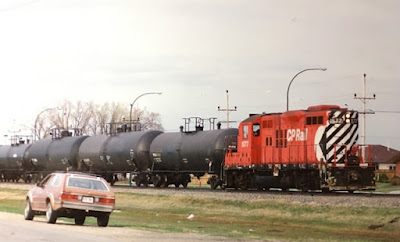After writing
four books about VIA Rail—
Trackside with VIA: The First 35 Years
and Trackside with VIA: Cross-Canada Compendium, Trackside with VIA: Consist Companion and Trackside
with VIA: Research & Recollection, Eric Gagnon has branched out on a different Canadian railway
topic: Trains & Grains,
Volumes 1 & 2.
In Volume 1, subtitled Trackside Observations in Manitoba 1976-1986, readers
can see photos, data and text showcasing the observations Eric made on several
trips to Portage la Prairie, Manitoba.
Volume 2, subtitled Grain
Elevators in Manitoba and Saskatchewan 1976-1986,
covers the traditional wood grain elevators that were railway-served in Manitoba
and Saskatchewan. Many of them are now long gone.
I posed some questions to Eric about
this new series.
Why did you write these
books?
For a few
reasons. I really enjoy the creative process, be it publishing a blog post
weekly or these more infrequent projects on paper. And I needed a fall
and winter project that I could work on.
I decided to create Trains &
Grains on the very day that my fourth book on VIA Rail was launched.
What
motivated me to do this project was I had several years' worth of photos taken
in Western Canada that I hadn't scanned nor shared yet on my
Trackside Treasure blog. The
Trains & Grains project
would force me to finally get all these photo prints scanned and digitized.
This
process was not only a pleasant diversion from the wintry weather, it also led
me down memory lane reliving my railfanning days in Portage la Prairie.
Why that time period?
From the
age of 12 to 22, I got hooked on visiting Western Canada. My aunt and uncle in
Portage made a habit of hosting me and my siblings for vacations. While there,
I was able to take many photos of trains.
In
retrospect, it was a great time to be there. Those were years of great change
to not only railway operations, but also grain industry operations ; the two
are inextricably linked in the West.
After a
long period of no change, the railways rehabilitated many branchlines and
invested, along with the government, to keep grain moving. And even bigger changes
were on the horizon, such as unit trains loaded at one high-throughput concrete
elevators.
Did you have any help with
the books?
In each
of my book projects, I've made a point of bringing others into the fold—contributors
whose expertise I respect and value. Each contributor adds more to a topic than
I could alone.
For Trains & Grains, Mark Perry and
Chuck Bohi provided photos to accompany the text pieces they contributed.
I'm also
proud to include a foreword for each book from Winnipeg blogger and
photographer Steve Boyko, and Randy O'Brien, who is modelling Portage la
Prairie and doing some amazing modelling (although he lives in Niagara Falls).
How many photos are in the
books?
I haven't
counted the photos in the printed, finished product, but if anyone does care to
count, there should be over 700 photos total!
Who are
the books for?
For me, for
a start. Like my blog, I am preserving photos and data in a form that I can
easily access. If others can (and I hope they will) get something valuable from
my efforts, so much the better!
For Trains & Grains, I set the bar
rather low, anticipating ten such folks across Canada might be interested in
owning a copy. For the most part, my early surveys indicated that readers who
are interested in trains are indeed interested in grains, too.
What things might people
surprising about trains and grains?
The
linkage between railways and grain farming and marketing is a tight one. When I
conceived this project, I naively thought that one book could contain all that
I wanted to share. Though the material fit together well, I realized early on
that the content was about to burst the covers.
As a
result, I had to divide one book into two. There is no overlap between the two
volumes, though I believe they complement each other. (Especially as they were
intended to be only one book!)
How can this help someone
who models the Canadian prairies?
There is
not that much cohesive information available about what rolling stock was used
on what train in the 1970s and 1980s. There are lots of stock photos available
online, but specific details such as sample car numbers, and what type of train
operated in what years, is not easy to find.
My books
trace the transition from grain boxcars to the colourful cylindrical covered
hoppers that are often called iconic items indicative of Canadian railroading.
Though not a social history, my grain elevator photos place these purpose-built
buildings in context with stations, other railway structures, towns,
branchlines and yards. There is lots of material for modellers to mull over.
They've
done well! They are sold in Europe, the U.S. and across Canada. Over 1,200
copies have been purchased, all told. I am most proud that my books on VIA Rail
have found their way into the hands of VIAphiles and VIA modellers, and that
they help manufacturers such as Rapido Trains Inc. to make Canadian railway
modelling achievable.
Of
course, much credit for this entire marketplace has to be given to Canadian Railway Modeller magazine for
showing the world what we already knew: Canadian railroading is cool!
How much are the books? And
how can they be ordered?
Each
volume is available for $35, including shipping in a padded mailer to Canadian
addresses. I'm committed to keeping pricing reasonable. For full ordering
information, please see:
http://trainsandgrains.blogspot.com/














